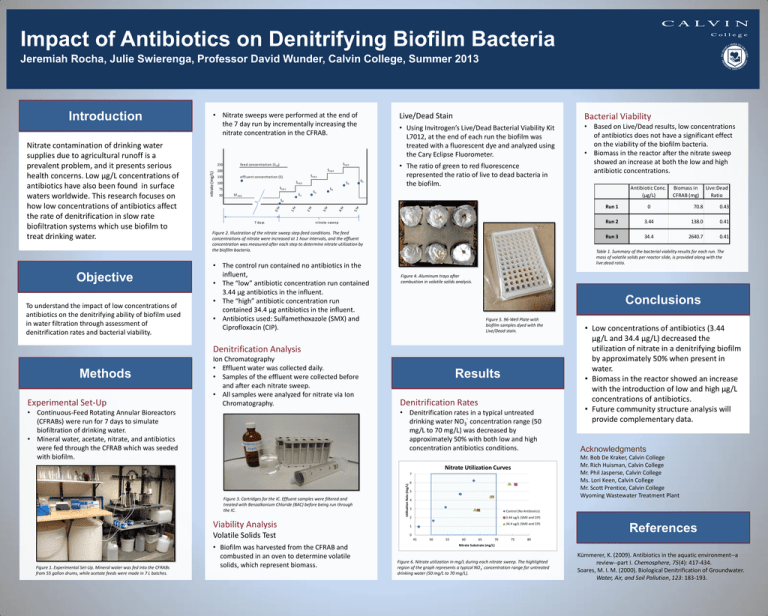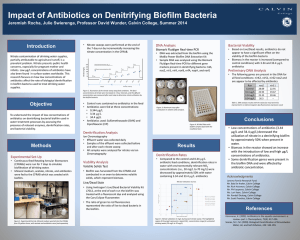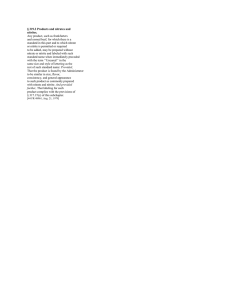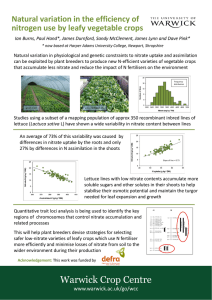Document 14405800
advertisement

Impact of Antibiotics on Denitrifying Biofilm Bacteria Jeremiah Rocha, Julie Swierenga, Professor David Wunder, Calvin College, Summer 2013 Objective To understand the impact of low concentrations of antibiotics on the denitrifying ability of biofilm used in water filtration through assessment of denitrification rates and bacterial viability. 250 S inf,5 feed concentra tion (S inf) S inf,4 200 150 S inf,2 100 S3 S2 S1 SF inf,0 S5 S4 S inf,1 75 50 S inf,3 effl uent concentra tion (S) Live/Dead Stain Bacterial Viability • Using Invitrogen’s Live/Dead Bacterial Viability Kit L7012, at the end of each run the biofilm was treated with a fluorescent dye and analyzed using the Cary Eclipse Fluorometer. • Based on Live/Dead results, low concentrations of antibiotics does not have a significant effect on the viability of the biofilm bacteria. • Biomass in the reactor after the nitrate sweep showed an increase at both the low and high antibiotic concentrations. • The ratio of green to red fluorescence represented the ratio of live to dead bacteria in the biofilm. 5h r 4h r 3h r 2h r 1h r 7 da ys ni tra te s weep Figure 2. Illustration of the nitrate sweep step-feed conditions. The feed concentrations of nitrate were increased at 1 hour intervals, and the effluent concentration was measured after each step to determine nitrate utilization by the biofilm bacteria. Experimental Set-Up • The control run contained no antibiotics in the influent, • The “low” antibiotic concentration run contained 3.44 µg antibiotics in the influent. • The “high” antibiotic concentration run contained 34.4 µg antibiotics in the influent. • Antibiotics used: Sulfamethoxazole (SMX) and Ciprofloxacin (CIP). Ion Chromatography • Effluent water was collected daily. • Samples of the effluent were collected before and after each nitrate sweep. • All samples were analyzed for nitrate via Ion Chromatography. Live:Dead Ratio Figure 5. 96-Well Plate with biofilm samples dyed with the Live/Dead stain. Results Denitrification Rates 70.8 0.43 Run 2 3.44 138.0 0.41 Run 3 34.4 2640.7 0.41 Utilization Rate (mg/L) 6 5 4 3 1 Volatile Solids Test 0 Acknowledgments Control (No Antibiotics) 3.44 ug/L (SMX and CIP) 2 Viability Analysis • Low concentrations of antibiotics (3.44 µg/L and 34.4 µg/L) decreased the utilization of nitrate in a denitrifying biofilm by approximately 50% when present in water. • Biomass in the reactor showed an increase with the introduction of low and high µg/L concentrations of antibiotics. • Future community structure analysis will provide complementary data. Mr. Bob De Kraker, Calvin College Mr. Rich Huisman, Calvin College Mr. Phil Jasperse, Calvin College Ms. Lori Keen, Calvin College Mr. Scott Prentice, Calvin College Wyoming Wastewater Treatment Plant 7 • Biofilm was harvested from the CFRAB and combusted in an oven to determine volatile solids, which represent biomass. 0 Conclusions Nitrate Utilization Curves Figure 3. Cartridges for the IC. Effluent samples were filtered and treated with Benzalkonium Chloride (BAC) before being run through the IC. Run 1 Figure 4. Aluminum trays after combustion in volatile solids analysis. • Denitrification rates in a typical untreated drinking water NO3 concentration range (50 mg/L to 70 mg/L) was decreased by approximately 50% with both low and high concentration antibiotics conditions. • Continuous-Feed Rotating Annular Bioreactors (CFRABs) were run for 7 days to simulate biofiltration of drinking water. • Mineral water, acetate, nitrate, and antibiotics were fed through the CFRAB which was seeded with biofilm. Figure 1. Experimental Set-Up. Mineral water was fed into the CFRABs from 55 gallon drums, while acetate feeds were made in 7 L batches. Biomass in CFRAB (mg) Table 1. Summary of the bacterial viability results for each run. The mass of volatile solids per reactor slide, is provided along with the live:dead ratio. Denitrification Analysis Methods Antibiotic Conc. (µg/L) S0 0h r Nitrate contamination of drinking water supplies due to agricultural runoff is a prevalent problem, and it presents serious health concerns. Low µg/L concentrations of antibiotics have also been found in surface waters worldwide. This research focuses on how low concentrations of antibiotics affect the rate of denitrification in slow rate biofiltration systems which use biofilm to treat drinking water. • Nitrate sweeps were performed at the end of the 7 day run by incrementally increasing the nitrate concentration in the CFRAB. nitrate (mg/L) Introduction 34.4 ug/L (SMX and CIP) 45 50 55 60 65 70 75 References 80 Nitrate Substrate (mg/L) Figure 6. Nitrate utilization in mg/L during each nitrate sweep. The highlighted region of the graph represents a typical NO3- concentration range for untreated drinking water (50 mg/L to 70 mg/L). Kümmerer, K. (2009). Antibiotics in the aquatic environment--a review--part I. Chemosphere, 75(4): 417-434. Soares, M. I. M. (2000). Biological Denitrification of Groundwater. Water, Air, and Soil Pollution, 123: 183-193.







